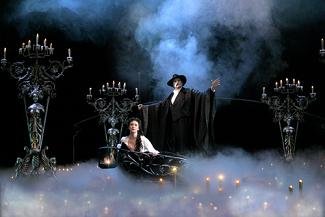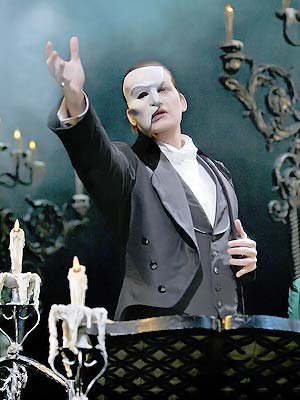 It’s been nearly a quarter of a century since Andrew Lloyd Webber’s “The Phantom of the Opera” made its debut in London’s West End and the show has remained a money-spinner ever since. That’s quite remarkable in the theater world, where today’s hot ticket can easily turn into tomorrow’s big yawn.
It’s been nearly a quarter of a century since Andrew Lloyd Webber’s “The Phantom of the Opera” made its debut in London’s West End and the show has remained a money-spinner ever since. That’s quite remarkable in the theater world, where today’s hot ticket can easily turn into tomorrow’s big yawn.
Why has “Phantom” continued to cast its spell over audiences while countless other (and some would say better) musicals have come and gone? That’s a question even Lloyd Webber probably couldn’t answer: Nothing he has created since -- “Aspects of Love,” “Whistle Down the Wind,” “The Woman in White,” “The Beautiful Game” (now revised as “The Boys in the Photograph”), even “Sunset Boulevard” -- has come close to matching “Phantom,” and the tepid-to-terrible reviews for his long-in-gestation “Phantom” sequel, “Love Never Dies” (which opened this spring in London and will come to Broadway later this year), don’t seem to bode well for its future prospects.
The good news for longtime “Phantom” fans, or for those who might be catching the show for the first time, is that the current tour (playing through June 3 at Wharton Center) is a solid, suitably spectacular version of the blockbuster. All the familiar elements are in place: the gondola cutting through the fog on a subterranean lake; the fireballs in the graveyard; the teeter-tottering ramps leading into the Phantom’s underground domain; and, of course, that sensational stunt with the chandelier that brings Act One to a (literally) smashing finale.
 Just as importantly, Tim Martin Gleason (in the title role), Trista Moldovan as Christine, and Sean MacLaughlin as Raoul, give vibrant voice to the score, which is now as familiar to musical theater buffs as anything by Rodgers and Hammerstein or Jerome Kern. Gleason in particular demonstrates crystal-clear enunciation that allows him to give his lyrics an extra punch of drama that has eluded many other Phantoms over the years.
Just as importantly, Tim Martin Gleason (in the title role), Trista Moldovan as Christine, and Sean MacLaughlin as Raoul, give vibrant voice to the score, which is now as familiar to musical theater buffs as anything by Rodgers and Hammerstein or Jerome Kern. Gleason in particular demonstrates crystal-clear enunciation that allows him to give his lyrics an extra punch of drama that has eluded many other Phantoms over the years.
The plot, adapted from Gaston Leroux’s 1911 novel, is built around a tragic love triangle. Christine, a chorus girl in the Paris Opera House, is caught in a romantic tug-of-war between a childhood sweetheart who has grown up to become the dashing vicomte, Raoul, and her mysterious mentor, an unseen “angel of music” who has been grooming her to succeed Carlotta (Kim Stengel), the company’s pompous prima donna.
Shortly after Christine scores a triumph by replacing Carlotta on opening night, the Phantom seizes the opportunity to lure his young student into his macabre private paradise, although his hopes for a romantic liaison are spoiled when Christine can’t resist removing the mask he wears to cover his distorted, scarred face. Unsurprisingly, Christine seeks solace in the arms of Raoul: He may not be much of a vocal coach, but he’s certainly a lot easier on the eyes. Equally unsurprisingly, the Phantom does not take this news well.
Although the role of Christine was originally designed to showcase Lloyd Webber’s then-lady-love Sarah Brightman, it’s actually a somewhat shallow, colorless character. Moldovan enhances it as much as possible by amplifying Christine’s divided heart and dropping a few extra grace notes of anguish and confusion into “Twisted Every Way” and “Wishing You Were Somehow Here Again.” Her silvery, swooping soprano is beautifully suited to “Think of Me” and “I Remember,” and she and Gleason send their slow-boiling duet, “The Point of No Return,” to a passionate peak. Moldovan and MacLaughlin work similar magic on “All I Ask of You,” investing Lloyd Webber’s swoon-worthy melody with warmth instead of histrionics.
Stengel is a haughty hoot as Carlotta, while Luke Grooms, as the Opera’s portly resident tenor, works comic wonders with an Italian accent that twists his tongue like rotini. As Madame Giry, the ballet mistress who may know more about the Phantom than anyone else, Nancy Hess is a formidable figure.
The gilded stage trimmings and spangle-studded, bejeweled costumes are first-rate in every respect and, as the “Masquerade” staircase ballet demonstrates, this is not one of those tours in which corners have been cut or spectacle has been scaled down. The only major stumbling block here is the sound mixing during some of the ensemble numbers, such as “Notes” and “Prima Donna,” in which the layered vocals often become murky and indistinct. Even so, it’s ultimately the solos and duets that fuel “Phantom,” and, in those numbers, Gleason, Moldovan and MacLaughlin frequently manage to both rattle the rafters and stir the heart.
Support City Pulse - Donate Today!
Comments
No comments on this item Please log in to comment by clicking here